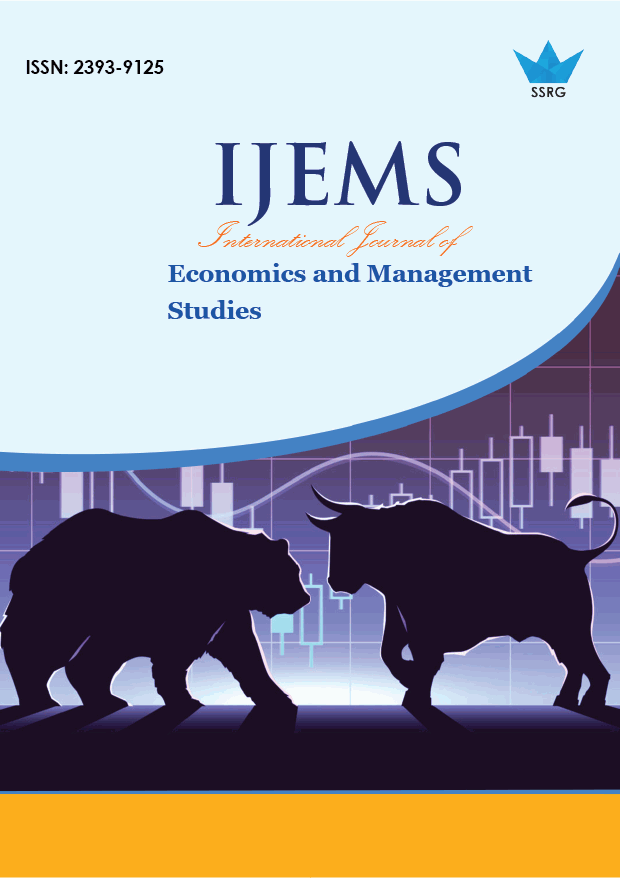Evaluating Perceived Quality, Brand Awareness, and Equity: Insights from Casio, Tissot, and Rolex

| International Journal of Economics and Management Studies |
| © 2025 by SSRG - IJEMS Journal |
| Volume 12 Issue 9 |
| Year of Publication : 2025 |
| Authors : Yuvraj Surana |
How to Cite?
Yuvraj Surana, "Evaluating Perceived Quality, Brand Awareness, and Equity: Insights from Casio, Tissot, and Rolex," SSRG International Journal of Economics and Management Studies, vol. 12, no. 9, pp. 40-47, 2025. Crossref, https://doi.org/10.14445/23939125/IJEMS-V12I9P104
Abstract:
The Indian watch market presents a unique blend of luxury and mid-tier consumer preferences, where perceptions of brand quality, awareness, and equity vary across demographic segments. This study compares three prominent watch brands, Casio, Tissot, and Rolex, to assess the influence of gender, household income, and city type on consumer evaluations. Data were collected from 86 respondents and analyzed using one-way ANOVA and independent t-tests. Results indicate that Rolex consistently outperforms Casio and Tissot in perceived quality, brand awareness, and brand equity, driven by its heritage, exclusivity, and strong brand culture. Casio and Tissot were perceived similarly, highlighting competition within the mid-tier segment. Gender-based analysis revealed that males consistently rated all constructs higher than females, while lower-income respondents viewed Casio and Tissot more favorably than higher-income respondents. No significant differences emerged across city tiers. These findings suggest that luxury brands should continue leveraging heritage and exclusivity to maintain equity, while mid-tier brands should emphasize value and aspirational appeal. Additionally, opportunities exist for targeting underrepresented consumer segments, particularly women, to expand market reach.
Keywords:
Perceived Quality, Brand Awareness, Brand Equity, Luxury watches, Consumer Perception.
References:
[1] David A. Aaker, Managing Brand Equity, Free Press, 2009.
[Google Scholar] [Publisher Link]
[2] David A. Aaker, “Managing Brand Equity: Capitalizing on the Value of a Brand Name,” Internet Archive, 1991.
[Google Scholar] [Publisher Link]
[3] Unilever, Delivering Sustainable Business Performance: Unilever Annual Report and Accounts 2022, 2022. [Online]. Available: https://www.unilever.com/files/92ui5egz/production/0daddecec3fdde4d47d907689fe19e040aab9c58.pdf
[4] Boonghee Yoo, and Naveen Donthu, “Developing and Validating a Multidimensional Consumer-Based Brand Equity Scale,” Journal of Business Research, vol. 52, no. 1, pp. 1-14, 2001.
[CrossRef] [Google Scholar] [Publisher Link]
[5] Vertica Bhardwaj, Archana Kumar, and Youn-Kyung Kim, “Brand Analyses of U.S. Global and Local Brands in India: The Case of Levi’s,” Journal of Global Marketing, vol. 23, no. 1, pp. 80-94, 2010.
[CrossRef] [Google Scholar] [Publisher Link]
[6] Saima Khan, and Bilal Mustafa Khan, “Measuring Brand Equity of Foreign Fashion Apparels in the Indian Market,” Journal for Global Business Advancement, vol. 10, no. 1, pp. 26-42, 2017.
[CrossRef] [Google Scholar] [Publisher Link]
[7] Vasantha K. Kumar, and Infant Emiliya, “A Study on Customer Satisfaction to Online Cab Booking with Special Reference Towards Coimbatore City,” International Journal of Engineering and Advanced Research Technology, vol. 10, no. 3, 2024. Online. [Available]: https://www.researchgate.net/publication/384608151_A_Study_On_Customers_Satisfaction_Towards_Titan_Watch_With_Special_Ref erence_To_Coimbatore_City
[8] Mondor Intelligence, Watch Industry in India - Size, Share & Market Overview, 2025. [Online]. Available: https://www.mordorintelligence.com/industry-reports/india-watch-market
[9] Statista, Watches & Jewelry - India Statista Market Forecast, 2025. [Online]. Available: https://www.statista.com/outlook/cmo/accessories/watches-jewelry/india
[10] Pedro Mir, Patricia Sanmiguel, and Maria Eugenia Josa, “How Old is Good for Rolex? Fashioning Heritage and Innovation into Strategic Advantage,” Global Fashion Management Conference, vol. 2019, 2019.
[CrossRef] [Google Scholar] [Publisher Link]
[11] Akshay R. Rao, and Kent B. Monroe, “The Effect of Price, Brand Name, and Store Name on Buyers’ Perceptions of Product Quality: An Integrative Review,” Journal of Marketing Research, vol. 26, no. 3, pp. 351–357, 1989.
[CrossRef] [Google Scholar] [Publisher Link]
[12] Teresa Sádaba, and Pedro Mir Bernal, “History as Luxury Brand Enhancement,” Luxury, vol. 5, no. 3, pp. 231-243, 2018.
[CrossRef] [Google Scholar] [Publisher Link]
[13] Eunju Ko, John P. Costello, Charles R. Taylor, “What is a Luxury Brand? A New Definition and Review of the Literature,” Journal of Business Research, vol. 99, pp. 405-413, 2017.
[CrossRef] [Google Scholar] [Publisher Link]
[14] Jean-Louis Chandon, Gilles Laurent, and Pierre Valette-Florence, “Pursuing the Concept of Luxury: Introduction to the JBR Special Issue on ‘Luxury Marketing from Tradition To Innovation,’” Journal of Business Research, vol. 69, no. 1, pp. 299-303, 2015.
[CrossRef] [Google Scholar] [Publisher Link]
[15] Cathy Bakewell, and Vincent-Wayne Mitchell, “Male Versus Female Consumer Decision Making Styles,” Journal of Business Research, vol. 59, no. 12, pp. 1297-1300, 2006.
[CrossRef] [Google Scholar] [Publisher Link]
[16] Manali Gupta et al., “Gender Differences in the Wearable Preferences, Device and Advertising Value Perceptions: Smartwatches vs. Fitness Trackers,” International Journal of Technology Marketing, vol. 14, no. 2, pp. 199-225, 2020.
[CrossRef] [Google Scholar] [Publisher Link]
[17] Leila Andervazh et al., “The Influence of Brand Trust and Customer Satisfaction on Customer Loyalty by SEM,” Journal of Basic and Applied Scientific Research, vol. 3, no. 9, pp. 687-693, 2013.
[Google Scholar]
[18] Arghavan Nia, and Judith Lynne Zaichkowsky, “Do Counterfeits Devalue the Ownership of Luxury Brands?,” Journal of Product & Brand Management, vol. 9, no. 7, pp. 485-497, 2000.
[CrossRef] [Google Scholar] [Publisher Link]
[19] Andrea Velandia-Morales, Rosa Rodríguez-Bailón, and Rocío Martínez, “Economic Inequality Increases the Preference for Status Consumption,” Frontiers in Psychology, vol. 12, pp. 1-16, 2022.
[CrossRef] [Google Scholar] [Publisher Link]
[20] Pingali Venugopal, “Urban Orientation of Rural Consumers: Implication for Consumer Goods Distribution,” International Journal of Rural Management, vol. 8, no. 1-2, pp. 107-119, 2012.
[CrossRef] [Google Scholar] [Publisher Link]

 10.14445/23939125/IJEMS-V12I9P104
10.14445/23939125/IJEMS-V12I9P104